Characteristics
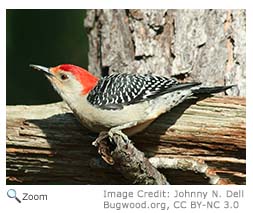 The red-bellied woodpecker has a light cream to pink chest and belly, barred black and white wings and back, reddish markings around its bill and a red crown. The male has red on the crown and on the nape of his neck. The female has red just on the nape of her neck. The red-bellied woodpecker has a light cream to pink chest and belly, barred black and white wings and back, reddish markings around its bill and a red crown. The male has red on the crown and on the nape of his neck. The female has red just on the nape of her neck.
Range
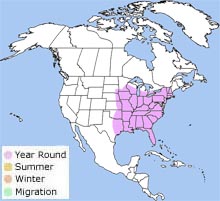 The red-bellied woodpecker can be found in most of the eastern United States, except for northern New England. Birds in the northern most part of the range may migrate in the winter. The red-bellied woodpecker can be found in most of the eastern United States, except for northern New England. Birds in the northern most part of the range may migrate in the winter.
Habitat
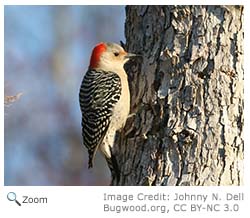 The red-bellied woodpecker makes its home in open and swampy woodlands. In the winter, birds in the northern most parts of the range may move south. The red-bellied woodpecker makes its home in open and swampy woodlands. In the winter, birds in the northern most parts of the range may move south.
|
|
Diet
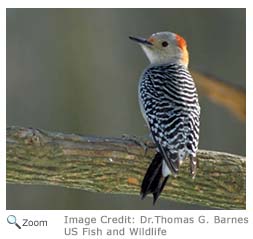 The red-bellied woodpecker eats beetles, grasshoppers, ants and other insects. It also eats acorns, beechnuts and fruits. It uses its bill to probe for insects in trees and tree stumps. The red-bellied woodpecker sometimes stores food in a tree cavity. In the winter, the red-bellied woodpecker's diet is mostly seeds and it can often be found at birdfeeders. The red-bellied woodpecker eats beetles, grasshoppers, ants and other insects. It also eats acorns, beechnuts and fruits. It uses its bill to probe for insects in trees and tree stumps. The red-bellied woodpecker sometimes stores food in a tree cavity. In the winter, the red-bellied woodpecker's diet is mostly seeds and it can often be found at birdfeeders.
Life Cycle
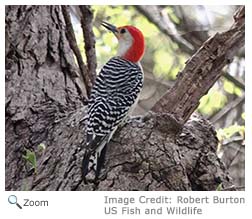 Red-bellied woodpeckers tap their bills together when they are courting. The nest cavity is built by both the male and the female. The cavity is lined with wood chips and is about a foot deep. It is usually built in a dead or dying tree. The female lays three to eight eggs and both the male and female incubate the eggs and care for the young. The male incubates at night. The chicks hatch in about three weeks and they fledge in about a month. The chicks usually stay with their parents until the fall. Red-bellied woodpeckers tap their bills together when they are courting. The nest cavity is built by both the male and the female. The cavity is lined with wood chips and is about a foot deep. It is usually built in a dead or dying tree. The female lays three to eight eggs and both the male and female incubate the eggs and care for the young. The male incubates at night. The chicks hatch in about three weeks and they fledge in about a month. The chicks usually stay with their parents until the fall.
Behavior
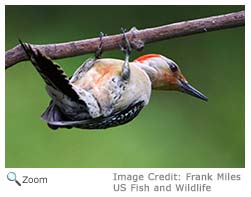 Red-bellied woodpeckers aggressively defend their nesting cavities, but starlings frequently take over their nesting sites. Red-bellied woodpeckers aggressively defend their nesting cavities, but starlings frequently take over their nesting sites.
|